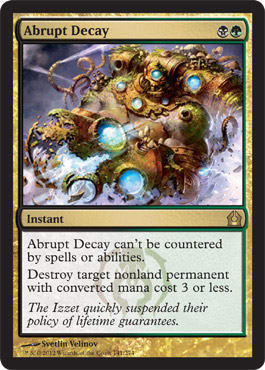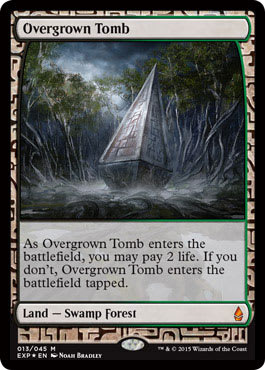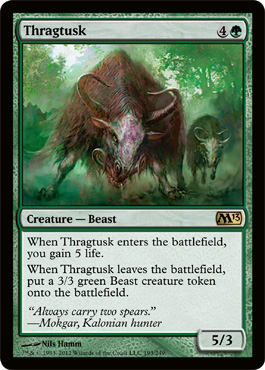With poker great and Magic all-star Dave Williams doing so well at Grand Prix: San Jose with his team, a lot of players are talking about the transition from Magic to poker that a lot of players are making. With similar skill sets being a benefit in both games, a lot of players find success in poker after success in Magic. I decided to look at the poker concept of going all-in on a particular hand: betting every chip you have for the chance to double up. If you lose, you’re out. If you win, you double what you had and you are in much better shape moving forward. Both in playing and in Magic finance, we commonly have the chance to go all-in. But how do we know when to hold ’em and when to fold ’em?
A Tale of Two Cards
Case 1
I fell in love with Abrupt Decay the second it was spoiled. I don’t play much constructed Magic, and when I do, it’s usually Legacy because it’s my favorite current format (because they ruined Extended!), and I don’t have to change my card stock up much. Financiers love Eternal formats because we have the kind of stock you need to be able to pick up Eternal staples without having to trade out your stuff at a loss, and you can keep the same deck for years with only minor tweaks. Abrupt Decay immediately struck me as a card that would have a huge impact on Legacy (Deathrite Shaman was another), and I immediately thought about how it would impact that format. Nice Counterbalance, bro! Tarmo who? Hang on, Merfolk player. I believe you’ll find your Force of Will is quite ineffective in stopping me, and your friend Cursecatcher is equally impotent! I AM A LEGACY MASTER!
Adding Decay to Maverick was going to give me access to Dark Confidant (or “Bad Sylvan Library” as some Maverick players call him) and take me toward a junk build where Thoughtseize was an option as well. I brewed up other decks as well, taking advantage of the power of Shardless Agent to hit all kinds of degenerate spells such as Ancestral Vision and Hymn to Tourach as well as Decay. More than nearly any spell in Return to Ravnica, Abrupt Decay stimulated the dormant deck-brewer part of my Magic genome and excited me about the set. They spoiled it early enough that I was able to be excited about the set for a long time.
Online, everyone was talking about this card. People were posting their B/G Zombies decklists before even seventy-five cards from the set were spoiled, and those lists featured Abrupt Decay prominently. It was initially offered as a $15 preorder and sold out so rapidly that it sold out at $20 before any other cards were sold out at their initial prices, and this was on a popular retail website that was offering Overgrown Tomb for $10. Everyone who managed to find their four copies for under $20 were telling anyone willing to listen about what a good bargain they got.
Given how good Abrupt Decay looked to me and how much it excited me both about the new Standard post-rotation and about Legacy moving forward, you’ll probably be surprised to hear that I preordered exactly zero copies of Abrupt Decay. Those pocket 10s looked good until my opponent raised an eyebrow—he hit that jack on the flop. Pocket 10s don’t always get there. Fold.
On Monday, October 8, 2012, Abrupt Decay could be purchased for $20 on eBay.
Case 2
I fell in love with Thragtusk the second it was spoiled. In a format that was just miserable to play green creatures that weren’t Dungrove Elder (a creature capable of hitting 10 power pretty reasonably in a game but that lacked the ability not to be chump-blocked by Lingering Souls tokens) due to Vapor Snag ruling the roost, a creature that gave you value both when it entered and left play seemed amazing—5 power, value, easy splashability. Thragtusk was the total package.
We had such a short window to play Dungrove Elder and Rancor together, so I turned my attentions to abusing Thragtusk in a favorite deck of mine: a Birthing Pod deck. He was at the perfect spot on the curve right before a Titan or Wurmcoil Engine, and he gave you value both when podded in and when podded out. I ran two main-decked, but I also had two in the sideboard for matchups in which I would want to draw one naturally or be able to pod more than one away. He slowed the game down enough and gave me extra life to mitigate losing some to greedy Pod activations.
The Internet was pretty receptive to Thragtusk. He was initially offered around $6 to $8, with many people cautioning that his price was almost certain to go down from there. He was a two-of main-decked at best, most likely a sideboard hero, but a nonmythic in a set like M13 should top out around $8. After all, he’s not a four-of in anything, and have you READ Thundermaw Hellkite?
Anyone not inclined to spend even $8 on Thragtusk was vindicated when it was announced that Thragtusk would be included in an event deck. Great! Now there will be a million more copies of him running around, creating a further glut on the market and driving his price down. If you got Thragtusks for any cheaper than $10, conventional wisdom said to dump them for whatever you could get for them if you were inclined to do anything but play with them because the card had nowhere to go but down.
Given all the forces exerting downward pressure on Thragtusk’s price and his announced inclusion in not one but two event decks (he’s slated to be in the upcoming Return to Ravnica event deck Creep and Conquer as a one-of in the sideboard), you may be surprised that I bought approximately all of the Thragtusks. My hand didn’t look great at the time, but I bet I was catching the inside straight on the river. All in.
On Monday, October 8, 2012, Thragtusk could be purchased for $12 on eBay.
Where Things Landed
On Monday, October 15, 2012 Thragtusk was sold out on multiple sites for $20, and Abrupt Decay was as cheap as $11.
Let’s get something straight right now. This isn’t an I-am-so-smart! article at all. I had the opportunity to buy Angel of Serenity at $8, and I jumped on this opportunity by buying a whopping four of them. I own fifty copies of Nivmagus Elemental and fifty copies of Martial Law. I have one hundred copies of Collective Blessing (I am not ruling this out yet, but for the moment, I look like a total chimpanzee holding a hundred copies). I am not broke because I am right a lot more often than I am wrong, but this isn’t about me patting myself on the back.
You could say I bet the percentages on both Thragtusk and Abrupt Decay.
How to Know When to Go All-In
Whether you’re buying all of the Jaces at $25 and none of the Vraskas at $25 or you’re playing the man instead of the hand, you have to take a minute to breathe and go into the tank. The same river card that can make or break your hand also has the same effect on your opponents’ grips. If a hand feels too good to be true, you may be feeling that way because the odds aren’t in your favor. However, if it feels like everything is lining up for you and you know the odds are in your favor, you can’t make any money not betting big.
— Michael Scott
Why Wouldn’t You ALWAYS Try to Double Up?
The board state in Magic—just as in all things—is constantly changing. You need to have an understanding of what could happen later in the game if you’re going to make an informed decision about how to play. Maybe buying Abrupt Decay at $20 preorder seemed as obvious as raising hard and fast with those pocket aces with another one on the felt. But maybe I wasn’t able to “swing for lethal” and show up with forty $8 copies of Angel of Serenity at States last weekend and trade them out at $25 because I played like the guy with a pair of 2s who’s too afraid of the flush draw he lost to last time to bet like a champion. If the right play were always obvious, no one would make any money at this game because no one would make a trade that wasn’t in his or her favor both then and forever, and no one would ever lose to anything other than his or her own mana base. But if you take a second to think and remember that Magic, like poker, is a game of percentages, you may just go all-in when Gatecrash preorder season rolls around.

























